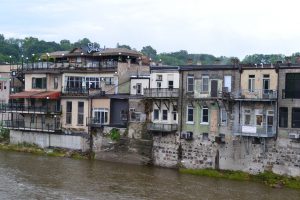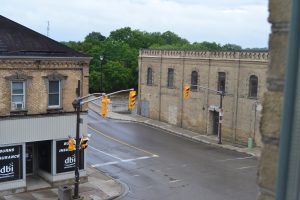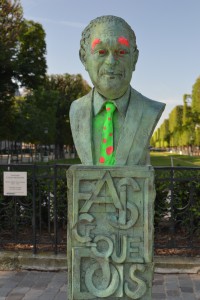I met Dennis Tourbin when I was nine years old. He and his then-wife, artist Denise Ireland, bought S.S. No. 8, the schoolhouse my Mum had attended, and when the For Sale sign came down, my mother had to see who’d moved into “her” schoolhouse. My parents liked this young artist couple, and regularly stopped en route to the cottage to visit. My parents had met each other at an Arts and Letters Club art class and my recently retired Dad was interested in the Bohemian lifestyle he’d never actually tried. He even grew a goatee. Those early days weren’t easy for Dennis and Denise; to make ends meet, she worked at a dress shop in Brookdale Plaza and Dennis pumped gas.
I remember Dennis coming to the cottage. My nine-year-old self trying to impress the adults with my best Jacques Cousteau imitation; snorkelling for hours, looking for crayfish under rocks in the shallow water, while the grownups talked on shore, maybe over a beer. Years later, Dennis told that he thought I was a really weird kid; I’m not sure that opinion ever changed. I knew by age ten that I was a writer. Although the solemn announcement to my family at age twelve drew snorts of derision, Dennis, this skinny guy who wore granny glasses and loud ties, took me seriously. He published my earliest work, and displayed numerous poems of mine in the Poetry Box outside Sandy’s Bookstore on Charlotte Street. In 1974, Dennis co-founded Artspace, along with David Bierk, John Moffat and others, still a going concern in downtown Peterborough.
As a teenager, I typed Dennis’s manuscripts from handwritten notes, learning more than I realized at the time. Once I could drive, I’d stop by the schoolhouse to talk and see new paintings and listen to stories. In 1982, he was artist-in-residence at the Canada Council’s Paris studio, and returned with watercolour collages, inspiration for the painted play Paris la Nuit, and some wild tales. I was dealing with my own crises involving parental health and, of course, boys. I remember attending a live reading of the complete Port Dalhousie Stories (Coach House Press, 1987) when it was recorded at Artspace. And I knew that it was a special night, one of those performances that stays in your flesh ever after. He was still living at the schoolhouse with Slim, a stray black cat, and Gladys, the Springer spaniel. With my Mum’s permission, he trapped minnows from the Bear Creek where it ran through her property, to bait bigger fish. He had a whole freezer full of fish—food that didn’t cost money. Dennis made it seem possible to live the artist’s life.
After marrying Nadia Laham late in 1983, Dennis moved from outside Peterborough to Ottawa, and I lost touch with him for a time. I lived in Ottawa briefly too, then an adult, but still caught up in my own drama and trying with difficulty to unpack difficult things that often defied words, or were, at least, beyond my writing skills at the time. I remember sitting in a pub on Bank St with Dennis and John Moffat and a few other artists (all guys, of course; it always seemed to work out that way) talking about art and people and drinking too much. At some point in the evening, Dennis would start the joke, “A horse walks into a bar. The bartender says, why the long face?” And he’d crack up, assuring everyone at the table that it would get funnier as the night wore on and we drank more. I miss those nights, but know they’re gone.
In 1991, the National Gallery of Canada in Ottawa purchased and exhibited a major work by Dennis, La crise d’octobre: chronology. According to Nadia, Dennis said it was “like winning the Stanley Cup” and when the exhibition was displayed, he’d hang out at the gallery, listening to viewers’ reactions, their responses to part of Canada’s collective memory. I was still in Ottawa when Dennis’s long-awaited National Gallery show was cancelled for fears that its political content around the October Crisis would prove too provocative in the environment of the 1995 Quebec referendum. It was a devastating moment to watch, when an artist comes so close to such an important show, at such a pivotal historical moment, and then it’s snatched away. It was a lesson in the volatility of art and politics; be careful what you say and when. Later, in 1997, La crise d’octobre: chronology was part of a National Gallery show that toured across Canada.
As I was leaving Ottawa, Black Squirrel Press offered to publish a chapbook of my work, the first time a collection of my poems would be wrapped in covers. submerge was published in 1997 and I asked Dennis to write the introduction. He wrote that it was the work of “a desperate voice searching for meaning” and also that it was a “book about the future.” But I’ll never forget what he asked me: “Why isn’t this a full book?” It was the moment that I knew I’d arrived. Dennis, my creative mentor, who’d watched me grow from this weird little kid snorkelling in the shallows, into someone who’d captured and developed her own voice, had identified me as a book-worthy writer. And although I’d known quietly for years that I was writer, and even though I’d had work published in literary journals by then, the fact that Dennis thought I was a writer, that he knew I had whole books in me, was incredibly powerful. The writing became more real; it felt like a responsibility. Dennis had identified my true calling, had named it, and expected me to do something about it.
In 1996, I moved to Toronto. I meant to stay in touch, to phone, to write, but I didn’t: I was waiting to show Dennis the first full book. In early May 1998, I got a phone call from another old friend, poet Michael Dennis, who told me that Dennis had suffered a major stroke and was in the hospital. Michael phoned with updates for the few days until Dennis died. I felt utterly lost.
I attended the funeral at Notre-Dame Cathedral in Ottawa, and the memorial across the street at the National Gallery. Both were packed. I returned to Toronto and tried to behave as if everything was normal. It wasn’t. Some sense of foundation had been eroded. I stopped writing. Within a few weeks, I became very ill with a viral infection; I was sicker than I’ve ever been and it took a couple of years to fully recover.
This winter, I turned the same age Dennis was when he died. I feel like I’m just getting started. Since he died, I’ve had two books published by Insomniac Press: blood love & boomerangs and Swimming in the Ocean. I’ve just finished a new novel—Pairs & Artichoke Hearts will appear between covers in the foreseeable future—and have a few other manuscripts brewing. After several stressful years, I’m back on track and can actually sit and focus and complete book-length work.
Last fall, shows of Dennis’s work appeared in both Ottawa and St Catharines, thanks in large part, I’m sure, to Nadia’s persistent efforts. The Firestone Gallery in Ottawa displayed a series of Dennis’s collage-style watercolours in dialogue with cubist artists. I was glad I went, but it only opened wounds and left me wanting more. Similarly, the work at the Niagara Artists Centre (a gallery he co-founded in 1969), the complete painted set for Paris la Nuit, brought back memories, but wasn’t enough. It was the Language of Visual Poetry exhibit at Rodman Hall in St Catharines that brought some relief and joy; I stayed immersed for hours. I saw paintings I hadn’t seen since I was a kid. And I realize that it’s only now that I can begin to understand what Dennis was doing as a multidisciplinary artist; it’s as if I’m seeing these canvases and painted objects and performance videos for the first time, through adult eyes and with some temporal distance. In the photos and videos displayed with these exhibits, he looks so young.
Dennis’s creative life mediated visual art and literature; looked at television through the lens of theatre; painted canvases not just with collages of images, but with words—words referencing yesterday’s newspaper headlines torn off, abridged, and out of context; words that painted stories over a series of vibrant canvases that filled whole gallery walls. Images of brightly painted poems inspired by Picasso and Tom Thompson and McLuhan and Pop Art and the FLQ and the October Crisis and Paris and Buckhorn and Jackson’s cows and television and mass media and fishing streams and conversations and the landscape and the city and memory and meaning and wonder and truth and life.
Thanks to Nadia Laham for correcting some factual errors.
© Catherine Jenkins, 2013
Like this:
Like Loading...










